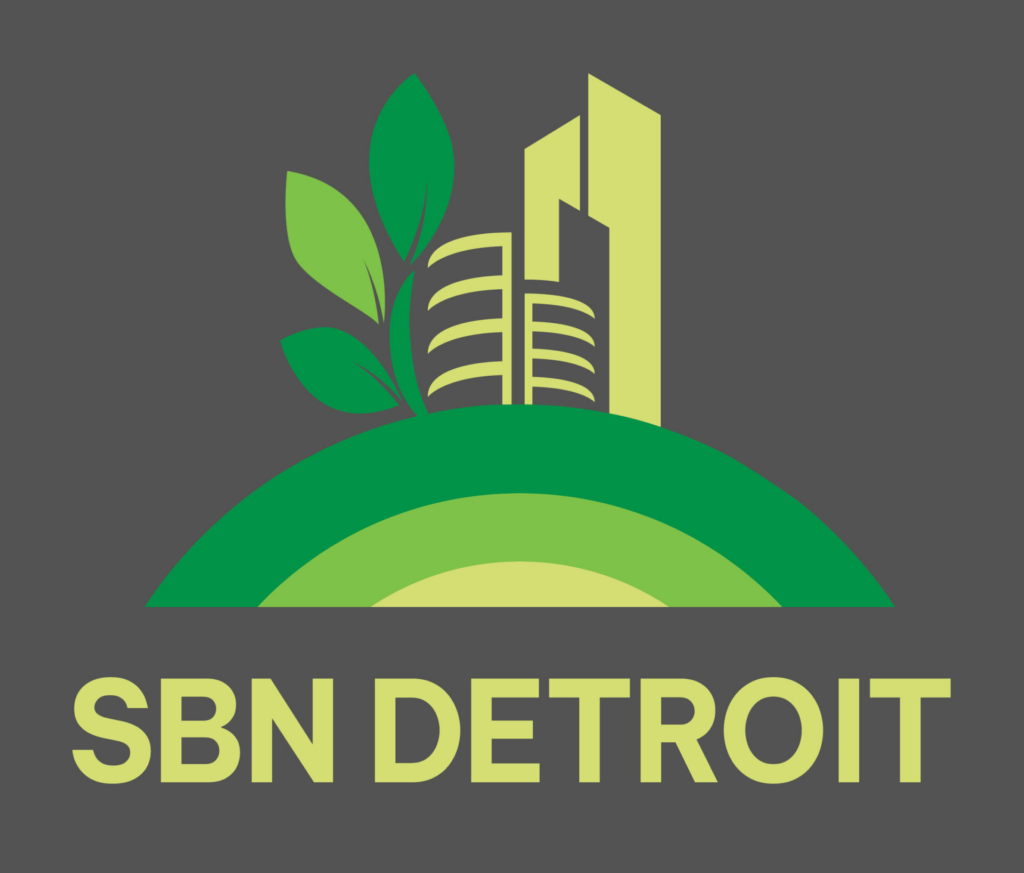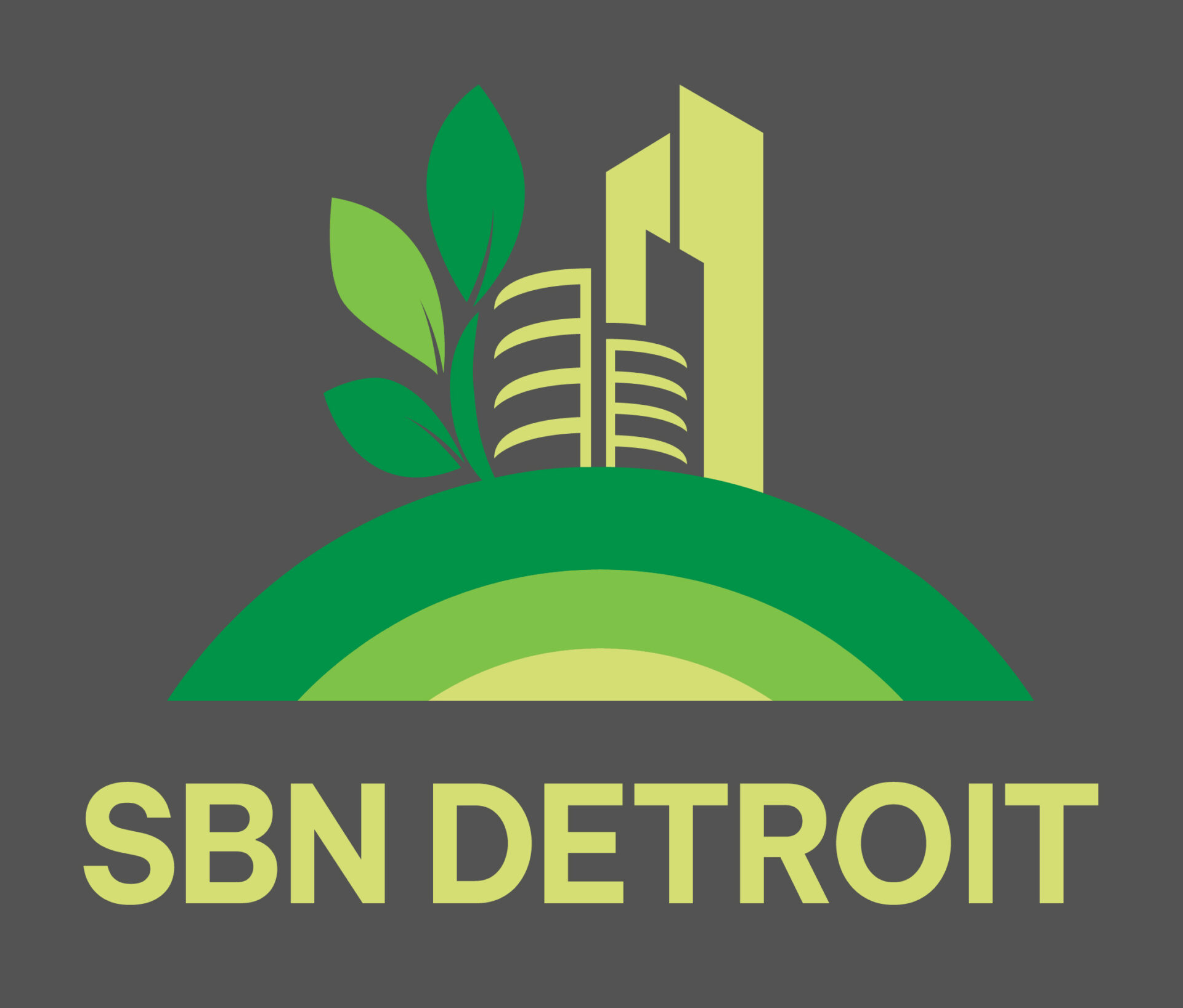Actionable Sustainability Initiatives for Businesses from Detroit’s First Director of Sustainability
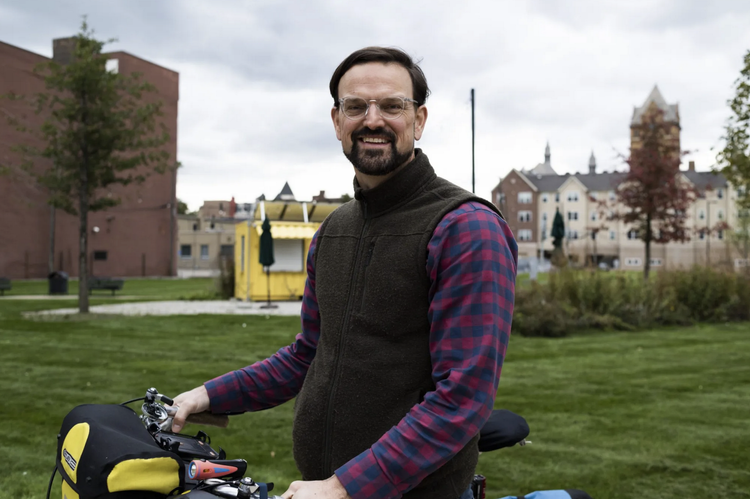
Joel Howrani Heeres, Detroit’s former, first, sustainability director, shared his thoughts about tangible initiatives businesses can integrate to work toward a cleaner environment. In his role, Howrani Heeres provides strategic leadership, tactical guidance, and technical skills to drive triple bottom line (environment, equity, & economics) strategy and actions to help Detroiters improve their lives by creating a healthier, greener, more vibrant city for all. Under Howrani Heere’s leadership, the Office of Sustainability had over 6,800 interactions with Detroiters and fostered partnerships with neighborhoods, businesses, and philanthropic and non-governmental organizations working to make Detroit more equitable, economically thriving, and environmentally healthy. Before taking this position, Howrani Heeres led sustainability and climate action planning at EcoWorks and served as managing director of the Southeast Michigan Regional Energy Office for DTE Energy. We asked him to share some steps that businesses can take to reduce energy and water usage as well as ensure residents are not experiencing impacts from climate and climate change. Track energy and water usage You manage what you measure, so start measuring. Data shows that once you begin tracking usage you’ll begin saving 3% in energy costs. A good opportunity for businesses to begin measuring and reducing energy waste is to join the Detroit Energy Challenge. This was launched in collaboration with the Detroit 2030 District and Michigan Battle of the Buildings, and it’s a free and friendly competition. Conduct an energy audit Doing a walk-through with an expert to point out things that can be done to save energy is invaluable. Within the city, we’ve conducted these audits now on 155 buildings and identified conservation measures that we are implementing. There are several audit programs available, such as DTE’s Business Energy Consultation. Update lighting A low-hanging fruit initiative is to update to LED. The cost to do so is coming down, and the cost of electricity is rising, so this is a win/win. Integrate renewables Integrating renewable or solar energy is a great action to take, especially if the electrical load is high. Companies can get a 26% tax credit for investing in solar. Check out the Detroit Solar Toolkit to identify your building’s solar potential. Join the global Race to Zero campaign Race To Zero participants are committed to achieving net-zero carbon emissions by 2050 at the latest. The city of Detroit has joined the campaign. Race to Zero’s intent is to rally leadership and support from businesses, cities, regions, and investors for a healthy, resilient, zero-carbon recovery that prevents future threats, creates decent jobs, and unlocks inclusive, sustainable growth. Electrification To get to net zero we must also think about electrification. We know we can clean the grid and introduce renewables, but we cannot clean natural gas. When you consider the cost of maintenance, gas, and parts on a gas-run vehicle, the total cost of electric vehicle ownership makes sense economically as well as environmentally. DTE offers a Charging Forward rebate program, so it pays to be an early adopter. Make investments in climate resilience We all remember last year’s flood event, and climate projections tell us that we’ll continue to see more and more extreme storms. Installing things such as backflow preventers, sump pumps, and generators are great considerations. Engage with neighbors Being a good corporate citizen and good neighbor reaps great benefits. I think businesses should talk to their communities and ask what things would make the neighborhood better. Also, look around at the land you own. Plant trees. Invest in biodiversity. Interested in getting assistance in setting up a sustainability program? Howrani Heeres points to DTE as a resource and also B Corp certification, a designation that a business is meeting high standards of social and environmental performance. Be sure to subscribe to our newsletter for regular updates on sustainable business practices in and around Detroit.
Dr. E’Lois Thomas, Working to Impact Lives that Have Been Underserved With Energy Solutions
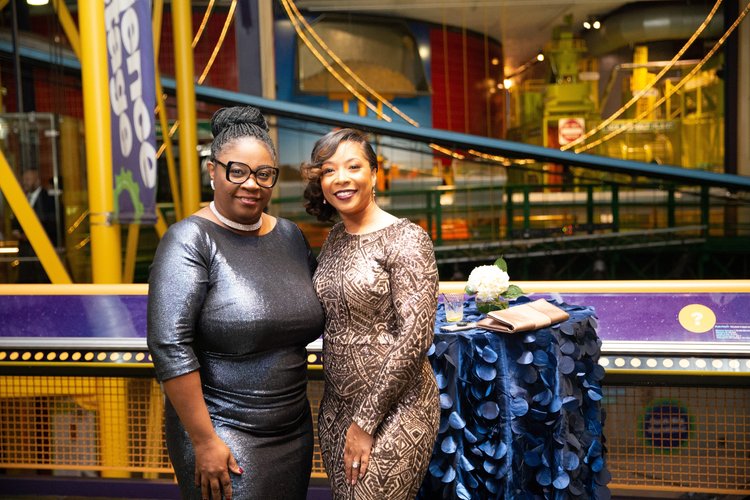
SBN Detroit interviews Dr. E’Lois Thomas, President of SEEL LLC (Solutions for Energy Efficient Logistics), a nationally certified MBE energy program implementation company that serves major utilities throughout the Midwest, South, and Northeast with expansion plans. Here, Thomas shares her thoughts on the correlation between energy resource development and expanding opportunities for disadvantaged minorities. Her leadership has helped SEEL to become one of the largest African American-owned implementation contractors working toward growth in sustainability, energy justice, and equality for all. Thomas is vice chair of the Midwest Energy Efficiency Alliance board, treasurer with Advancing Women in Energy, a member of the American Association of Blacks in Energy board, and a mentor for the Council of Women in Energy and Environmental Leadership. She is a big advocate of youth advancement and volunteers as a board member for RESULTS Mentoring, Detroit Police Athletic League (PAL), and Franklin Wright Settlements. Q: Can you tell me briefly about what work you are doing exactly with SEEL? A: I’ve been with SEEL for 11 years now and with the parent company for more than 20 years, and as president, I guide and oversee all aspects of the company’s operations and growth. Since joining the company, I have worked toward the company’s growth in an industry that is committed to combat the climate crisis. We’ve had to navigate an industry that is rapidly changing from gas and fossil fuels to electrification, renewable, and clean energy. Also, as a leading minority-owned disabled-veteran-owned company, energy access and equity are important to us. We’re intentional about including minorities and underrepresented groups in the conversation. Q: You are involved with the growth trajectory of SEEL – as such what is your vision for the future? A: We’ve been involved in the energy industry since the beginning of broad energy efficiency programs being implemented in communities. The goal then was to reduce the carbon footprint by educating utility customers about energy efficiency and retrofit their homes with energy efficiency products and services. Fast forward to today, the industry is rapidly adopting renewable and clean energy intending to become carbon neutral in the next 25 – 30 years. This provides a great opportunity to grow the company in diverse ways. In addition to offering services related to renewable and clean energy, services like weatherization, building performance, and workforce development all provide rewarding opportunities right now. Q: How will you reach these goals/this vision? A: By continuing to train the workforce of tomorrow, while making an impact on the quality of life of our current employees and the communities we serve. Training is critical, whether it’s training for skilled trades, continuous improvement, building science, energy justice, HVAC, solar, or the training of being an energy-efficiency professional with key attributes like customer service, etc. SEEL is committed to this education. Q: What are some examples of what some local programs SEEL has implemented? A: We are training up our team in renewable energy options like solar and completing pilot projects for community-based organizations and local churches. We are speaking in the community to ensure that electric vehicles include diverse communities by petitioning for inclusion and more charging stations in urban areas. We are collaborating with Detroit 2030 District which continues great work to reduce the environmental impact of buildings and operating costs for building owners/managers in Detroit. In Detroit, we were the first minority-owned corporation to join DTE’s MIGreenPower 100% clean energy at its headquarters. DTE Energy’s MIGreenPower program is among the top three voluntary renewable energy programs in the United States. Notably, MIGreenPower offers simple and affordable renewable energy programs to eligible electric customers, thereby supporting the company’s wind and solar projects. In addition, we are currently reviewing our fleet for fleet emissions reductions with a plan in place to transfer all assets by the end of 2023 to efficiency grade to reduce our carbon footprint. In the state, we also collaborate with Consumers Energy toward their clean energy goals by managing programs with their Clean Energy Plan poised to meet Michigan’s energy needs and to continue the journey to net-zero carbon emissions by 2040, and we implement the entire energy efficiency portfolio for the Upper Peninsula Power Co. (UPPCO), powering through together in one of the most rural, weather-challenged areas in America, and for Indiana Michigan Power as well. Q: What drives your passion? A: I know first-hand the disparities that exist in energy burden. I grew up on the east side of Detroit and graduated from Pershing High School in the Detroit Public Schools Community District. As a young African American student, I always aspired to help others, so what fuels me today is that every customer deserves a path to energy justice, and I have a quest to ensure that this path occurs for everyone, independent of their financial, social or economic status. Not only is energy equity a passion of mine personally and professionally with SEEL, but there is such an opportunity for our industry to impact lives and communities while reaching those that have been underserved for too long. Simply put, access to clean air is a human right, yet so many of us don’t have it. Change is overdue, so the priority is critical now. Q: Outside of SEEL you are involved in many organizations. One is the American Association of Blacks in Energy board. From your perspective, what is the correlation between energy resource development, economic growth, and minorities? A: The correlation between energy resource development, economic growth, and minorities has clearly shown a gap in the representation of minorities that organizations like AABE work to resolve. AABE is a resource for providing information and educating energy consumers from all sectors of society, with emphasis on marginalized communities ensuring that the public and private sectors are responsive to the problems, goals, and aspirations of African Americans. AABE recognizes that access to reliable and affordable energy is essential to everyone so from an inclusion standpoint, we make sure that African Americans are represented in the conversations politically, socially,
Detroiters Working for Environmental Justice Working Hard to Eliminate Health Disparities in Detroit
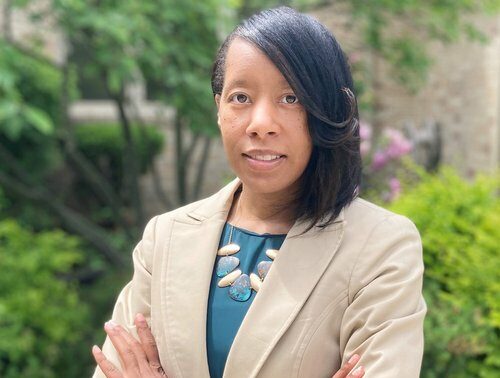
SBN Detroit talked to Laprisha Berry Daniels, Executive Director of Detroiters Working for Environmental Justice (DWEJ), an environmental/social justice organization committed to community engagement and policy change that lifts the voices of Detroiters. Daniels holds a bachelor’s degree in psychology from Michigan State University, as well as master’s degrees in social work and public health from the University of Michigan. With over 20 years of public health experience, she has been responsible for developing, implementing, and evaluating efforts focused on eliminating some of the most stubborn health disparities. Here she shares her thoughts and work in disrupting and dismantling the status quo to ultimately eliminate environmental health disparities in Detroit. Q: In June 2021 you took on the role of executive director for Detroiters Working for Environmental Justice. What is involved here? A: The work of Detroiters Working for Environmental Justice (DWEJ) started over 30 years ago. The vision then and now is to make certain all people benefit from environmental policies and practices that value the voices and reflect the will of impacted communities. As the executive director, I work with internal and external partners to challenge structures/systems that perpetuate racist and classist policies that negatively impact the well-being of Detroit and Detroiters. DWEJ is currently working with national organizers and local champions to push for adding a Green Amendment to the state’s constitution. Q: What are your short-term and longer-term goals and how will you reach them? A: DWEJ currently focuses on reducing environmental health disparities, specifically those related to asthma, lead poisoning, and cardiovascular disease (CVD). Our approaches to reducing these disparities involve combining education about illness related to environmental hazards with political action to reduce the environmental factors that lead to disease. Two recent efforts involved engaging community members around making public comments – first, at Detroit city council meetings to object to proposed changes in a rental ordinance that would put more children at risk for having elevated blood lead levels that compromise the physical and mental health of children and pregnant persons, and second, before the zoning appeals board to urge officials to protect the health and well-being of residents by denying a permit to have a new asphalt facility in northwest Detroit. Overall, we focus collaboration, outreach, education, and advocacy efforts on improving the natural and built environment so that the physical, spiritual, mental, and economic health of Detroiters is improved, protected, and maintained. Q: What are the biggest challenges? A: If Detroit is going to be a model city for sustainability, nonprofits, for-profits, industry, education systems, health systems, government, art institutions, etc. – and I think we can be – we must all work together as we look for creative and innovative solutions to challenges. We must honor the ideas, perspectives, voices, actions, and leadership of the communities impacted by decisions that are being made. We must listen to the people in the areas we work in – the daily issues that impact their lives. Q: What drives your passion here? A: I believe that anyone, anywhere can collaborate for the greater good. I have been part of some unlikely alliances that have created transformative change. For example, in previous work, I was responsible for recruiting volunteers ages 55 and up to read to elementary school students. I facilitated relationships with local motorcycle clubs and had bearded, tatted bikers volunteering to read to third graders, encouraging academic achievement and helping to improve school climate. I’m ready to be part of that process as we focus on transforming the way we collectively “do business” as consumers and producers in Detroit. Q: From your perspective – what is the role of businesses in Detroit in terms of sustainability overall for the city? Businesses of all sizes with varying goals, visions, and missions can engage in co-learning, collaboration, and collective action. Many of the challenges that we are facing are the result of a few making decisions that will impact many. Therein lies the problem. The biggest challenge to sustainability, in business and beyond, is clinging to the status quo or “business as usual.” We have to engage in some business that is unusual. For far too long the blame for environmental woes and the measures to fix the issues have been passed on to individuals. We can shift the conversation from asking individuals to reduce, reuse, and recycle to expecting businesses, especially big businesses, to respect, restore, and replenish. Q: What are businesses in Detroit that are doing it well? A: Pingree Detroit comes to mind when I think of sustainability, innovation, creativity, and collaboration. They serve as a prime example of how businesses of varying sizes that have varying impacts on the ecosystem can partner. Be sure to subscribe to our newsletter for regular updates on sustainable business practices in and around Detroit.
Gulay Serhatkulu, Setting the Right Priorities for a Climate Neutral and Circular Future

SBN Detroit interviews Dr. Gulay Serhatkulu, BASF Senior Vice President of Performance Materials North America. This business encompasses the entire materials know-how of BASF regarding innovative, customized plastics under one roof and is globally active in four major industry sectors – transportation, construction, industrial applications, and consumer goods. Serhatkulu joined BASF in 2006 as a technical service representative. She has held a variety of roles with increasing responsibility within BASF including product management, marketing, sales, strategy, and most recently procurement. Before BASF, she earned two postdoctoral appointments at the University of Nottingham, UK, and Wayne State University, respectively. Serhatkulu shares with us some insights on the projects, goals, and challenges she leads every day. Q: What is involved in your role in leading the sustainability team at BASF in the North American region? A: Plastics do have proven benefits during their use phase – for example, preservation of food loss, lightweight construction of vehicles, and building insulation. Plastic waste, however, and in particular plastic waste in the context of marine littering, is perceived as a major global challenge. There is also increasing regulatory pressure regarding recycling quota and recyclability on the one hand and strong commitments of our customers towards increasing the share of recycled material in their offerings on the other hand. Solving these challenges requires innovation and joint efforts globally across the value chain. A team across BASF has taken up this challenge and developed the ChemCycling™ project which focuses specifically on transforming plastic waste into a raw material using pyrolysis, a thermochemical process. The raw material can be fed into the existing assets to create new chemical products with excellent product performance based on recycled plastic waste. Besides ChemCycling, BASF offers other mass-balanced chemical or advanced recycling solutions based on different post-consumer and post-industrial feedstocks. In this case, the recycled feedstock is not a pyrolysis oil and is introduced as an intermediate during the manufacturing process and not at the very beginning as is the case of pyrolysis oil. Chemical recycling represents an exciting business opportunity for us and our customers, as the resulting products are of equal quality to the products derived from fossil feedstock. Nevertheless, many technical, economic, and regulatory questions have to be answered but we are eager to work on it and optimistic that we can cope with all challenges. Q: What are you currently working on in terms of sustainability for BASF? A: One great example is the BASF and Steelcase collaboration on the brand’s new Flex Perch Stool, which has sustainability and circularity at the forefront of its design. This is the first furniture product for Steelcase that uses plastics derived from a chemical or advanced recycling process. The stool is made with BASF’s Ultramid® B3EG6 Ccycled™, an injection moldable polyamide (nylon) 6 that utilizes material from a waste stream generated during electronics production and is a one-for-one replacement for the 100% fossil-derived plastics. I cannot stress enough the importance of value chain partnership to achieve these types of major breakthroughs. From a lightweight perspective, I can also point to a collaboration with Toyota on their Sienna. We also work with footwear companies to provide plastic and foam materials that have sustainability benefits such as being bio-based and recyclable. The new Sienna generation first-of-its-kind third-row free-standing seat backs. We also have efforts for Climate protection. Climate change and global warming are among the most pressing challenges of our time. On our journey toward climate neutrality, we have set ourselves ambitious goals and are striving worldwide to achieve net-zero CO2 emissions by 2050. At the heart of the long-term transition toward net-zero CO2 emissions by 2050 is the use of new technologies, which will replace fossil fuels such as natural gas with electricity from renewable sources. Additionally, we engage our suppliers in our ambition to serve our customers with the lowest carbon footprint materials possible. In our Supplier CO2 Management Program, we first aim to achieve transparency on the product-related CO2 emissions of our purchased raw materials. In this phase, we offer our support and share our knowledge on Product Carbon Footprint valuation methodologies and tools with our suppliers. Q: What are your longer-term goals there? A: We want to live up to our purpose: We create chemistry for a sustainable future. We are only successful if our products, solutions, and technologies add value to society. Therefore, we want to make a positive impact on society and safeguard our planet. To drive the sustainability transformation, we focus on three key topics: Climate change, Circular Economy, and a safe and sustainable portfolio. We are striving worldwide to achieve net-zero CO2 emissions by 2050. Q: What are the challenges you face? A: I see two main challenges. First, new technologies like electrically heated crackers, electric steam generation, carbon capture, and storage technologies need to be developed to achieve our targets. Some of these will take time to develop and they will first need to be piloted before being scaled up. Second, we need a supportive and enabling regulatory framework if the transformation is to succeed. Q: From your perspective, what role does BASF as a business play in terms of sustainability for the surrounding community? A: We measure the overall impact of economic, environmental, and social aspects of our business activities with our Value to Society methodology. We take sustainable use of water and preserving biodiversity seriously. Our global target is to implement sustainable water management at all production sites in water stress areas and our connected sites by 2030. We periodically investigate our production sites around the world to revise which are located near internationally protected areas. We connect with external stakeholders and networks to discuss our sustainability strategy. One local example is Fighting Island. Owned by BASF, Fighting Island is a 1,500-acre island on the Canadian side of the Detroit River in LaSalle, Ontario. The island was historically used for storage of lime tailings, a byproduct of soda ash production, in settling beds. Since closing the settling beds in 1982, BASF’s efforts have led to native revegetation and reforestation to help prevent erosion, reduce dust, increase wildlife habitat, control runoff, and enhance
The Wright – Committed to Preserving African American Culture – and the Environment
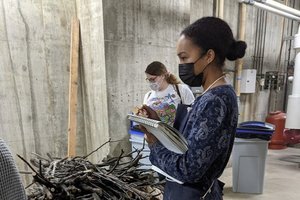
At their best, museums champion the exchange of ideas and the enrichment of intellect. As such, the Charles H. Wright Museum of African American History approaches sustainability within the context not only of preservation but also of education. The museum is at the forefront worldwide in its effort to make the work of sustainability visible in museums so that everyone can see that they have a stake in—and can contribute to—environmental preservation. The Wrights’ sustainability efforts formally took hold in 2015 upon hiring Leslie Tom, as its Chief Sustainability Officer who relocated from San Francisco by way of Arizona. Tom’s background in Architecture andInformation Management with a focus in the future of libraries, archives and museum domains were a perfect match for being the Third Cohort for a mid-career Detroit Revitalization Fellowship through Wayne State University. Of her role at The Wright, Tom says “To have the opportunity to combine my experience in environmental history and culture with the methodologies of service design and architecture and apply them at one of the oldest African American museums in the world is a dream job.” She goes on to say, The fact that the museum has a Sustainability Officer on staff illustrates its dedication and commitment to sustainability at all levels. Few museums even have this role. Under Tom’s leadership, The Wright has become a frontrunner in sustainability within the museum field. In 2019, The Wright was one of five museums to earn The Sustainability Excellence Award from the American Alliance of Museums Environment and Climate Network. Tom values the regional sustainability network and so helped to co-chair the inaugural Detroit 2030 District’s first Venue and Museums Committee. Detroit 2030 District is a part of a national movement to create high-performance building districts by reducing the environmental impacts of building. Tom points to three main areas of focus regarding the museums’ current sustainability efforts. “First is working to expand the triple bottom line [people, planet, prosperity and programs] and do what museums do well – engage learners,” she says. She gives d.Tree Studio as an example. When dying Zelkova trees were discovered on The Wright’s campus, instead of sending them to a landfill, the museum partnered with the College for Creative Studies to create d.Tree Studio – an ongoing wood shop class to explore connections between design, African American material culture/history, and sustainability. Students use the dying trees to make everything from a decolonized chess set to a fully-functioning record player. Second, is the Climate Action Framework, which The Wright museum supports through a green think tank team of museum staff, landscape architects, urban planners, designers, and community engagement plans all addressing the social and technical aspects of lowering the carbon footprint. Third, is the museum’s green work around the African World Festival. “We’ve been doing exciting green work since 2015 that’s finally being operationalized and next year will be line items in the budget,” she says. “This will include things like bike valets, recycling and compost space, sharing information at the festival and more.” She goes on to say, It’s been so satisfying to see co-creation and adoption by my colleagues and their inclinations increase toward a green institution. No one person can do it alone, and having mother nature break down silos, we’ve got support and work to do from the top down and bottom up. Some measurable initiatives The Wright has been involved with over the past several years include: The Wright’s proactive response to the August floods of 2014and increasing rain events created a collaboration with the Michigan Science Center where the result was a November 2019 convening calledRipple of Impact. Over 200 people visited our Green Stormwater Infrastructures to taste, touch, see, smell, feel the water. The Wright effectively manages nearly 19,000 gallons of stormwater each year removing 50,000 gallons of stormwater permanently from the sewer system overall. See the Stormwater Hub for more info. The Wright is continuing this work by hosting the Green Museum Town Hall with our Learning and Engagement and Sustainability Departments. Please check our website for our Green Museum Town Hall in mid-November 2022. In 2015, the museum installed Variable Fan Drives (VFDs) so museum pumps and motors do not run 24 hours per day, 7 days per week. From this effort, The Wright reduced its utility bill by $30,000. Due to green efforts around the African World Festival, The Wright has seen a 5% waste diversion rate increase, repurposed 536 pounds of recyclable material, and diverted 387 pounds of organics from landfills. A strong commitment to sustainability among The Wright’s staff has led to a 400% uptick in recycling rates on the museum campus. Of doing this work in Detroit, Tom says, “As an outsider coming into Detroit, I can say that I haven’t found another city where so much consideration and multi-generational collaboration is happening. Between the local organizations, nonprofits, and businesses the best practices coming out of Detroit are very impressive. To be working within this environment has true potential for addressing our climate crisis collectively.” When asked what project she’s most proud of, Tom says the investment made in 2019 to laser scan the entire museum building. “We now essentially have a digital twin of the building stored in the cloud, so that when we collaborate with landscape architects and engineers to invest in energy-efficient systems and more, we can upload the specs and leverage the data on how best to take care of this institution.” What’s next for The Wright? Tom says their continued work on creating a green museum of the future. “We are convening conversations and setting new standards. It’s an exciting place to be.” In closing, The Wright’s President and CEO, Neil Barclay says, “Inaction affects us all. So join The Wright as we transform spaces, hearts, and minds to make room for a more equitable future here in Detroit.” Be sure to subscribe to our newsletter for regular updates on sustainable business practices in and around Detroit.
Sustainability in Health Care: A Look at Henry Ford Health’s Green Efforts
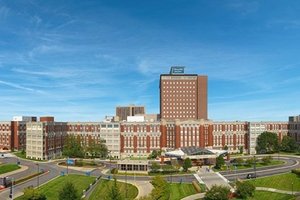
Health care leaders have the uniquechallenge of improving the health and well-being of the individuals, neighborhoods, and communities they serve while simultaneously working to minimize negative and health-depreciating impacts on the environment. We spoke to Chip Amoe, who became Henry Ford Health’s first director of sustainability in 2018, about the challenges and successes he faces as he leads HFH to become more ‘green.’ Founded in 1915 by Henry Ford himself, Henry Ford Health is a not-for-profit, academic, and integrated health system comprising five acute-care hospitals, three behavioral health facilities, a health plan, and 250-plus care sites including medical centers, same-day, and urgent care clinics, pharmacies, eye care facilities, and other health care operations. The health system has more than 33,000 employees and nearly 6,000 physicians and researchers. Amoe took on the role with a conviction that HFH can work to lead by example and help influence the sustainability policies and actions of government officials and other businesses in the state and region. His original initiatives focused on reducing plastic and Styrofoam waste, exploring ways to reduce greenhouse gas emissions through energy reduction, and standardizing efforts across the system. Toward the goal of reducing greenhouse gas emissions, in December 2021 Henry Ford announced they will begin purchasing wind and solar energy through DTE’s voluntary renewable energy program, MIGreenPower. Amoe says, Our overall goal here is to reduce scope 1 & 2 emissions by 50% by 2030. To do that we need to reduce emissions from purchased energy. We plan to start purchasing this renewable energy in 2023, the earliest it will be available, and ramp it up over time. To that end, initially, 10% (approximately 19,100 mega-watt hours) of Henry Ford’s total electricity purchased from DTE will come from Michigan-made renewable energy, increasing incrementally to 100% by 2029. Henry Ford’s clean energy commitment with DTE will begin in late 2023. The organization states its initial purchase will reduce greenhouse gas emissions by roughly 13,536 metric tons, the equivalent of removing 2,944 passenger vehicles from the road each year. In terms of setting longer-term goals, Amoe said, “There are several national organizations that have developed green healthcare standards for healthcare systems. Taking those into consideration, we also felt it was important to turnto our internal priorities that align directly with our mission of improving the health of the communities we serve and that link health and sustainability.” The following five goals are derived from that exercise: Reduce emissions from operations Eliminate chemicals of concern, i.e. furnishings, cleaning chemicals, certain medical devices Reduce waste to landfills, such as bottled water, food waste, packaging, and utilizing reprocessed equipment Increase the purchase of local and sustainable food Increase the investment in green and healthy infrastructure, such as green spaces, stormwater management, advocacy around public transportation and employee commuting, and more When asked what pitfalls Henry Ford Health faces in implementing green efforts, Amoe cited two large challenges. “Data collecting is a huge challenge,” he said. “When I came on board I assumed the information was being collected and housed so that we could track it. But I quickly learned that wasn’t the case.We’re a large, complex system and there are multiple data sources maintained by multiple departments so you inevitably come to understand thereare gaps in the information. And you can’t move what you can’t measure. We are working to streamline our data collection efforts and it’s a long process.” The second challenge is the state of the U.S. recycling market. Just as I started my role in 2018, China announced that it would no longer be accepting recycled material from the U.S. This has been a big hit to the U.S. recycling market and made it much more challenging. Combine that with low landfill tipping fees in the state and the lack of recycling infrastructure in the region and that means recycling is often more expensive than throwing things away. Despite the challenges, Amoe and the Henry Ford team have implemented several initiatives in the past four years, including: Reducing the use of more potent anesthetic gasses from operating rooms to reduce emissions Eliminating Styrofoam from all their retail locations Upgrading exterior lighting to reduce energy waste Hosting their first zero-waste event They have also partnered with Friends of the Rouge to create raingardens at their new Plymouth medical center and south campus to divert stormwater and offer green space. When asked what the health care industry could improve on to forward sustainability efforts, Amoe said “it’s important to come together as an industry around common standards, and work with outside vendors as an industry to request and gather data in a common format so that vendors know how they can help us meet our shared goals of improving the health of our communities Additionally, the Michigan Health and Hospital Association Green Health Care Committee – which Amoe chairs – recently launched an MHA-approved Health Care Sustainability Road Map to give health systems a place to start when it comes to sustainability. “We are working to develop common standards and to provide resources to hospitals in Michigan and beyond.” In the end, Amoe says, “We hope to demonstrate to our staff, patients, vendors, and surrounding businesses the connection between health and sustainability, and further, to facilitate positive choices that impact the overall health of our community.” Be sure to subscribe to our newsletter for regular updates on sustainable business practices in and around Detroit.
Kerry C. Duggan Works With Game-Changing Sustainability Businesses in Detroit

SBND interviews Kerry C. Duggan,national political advisor and visionary climatech executive and former Obama White House official. Founder and CEO of SustainabiliD in Detroit, and recently named the founding director of the University of Michigan’s SEAS Sustainability Clinic, Duggan shares her thoughts on a local level, highlighting key women and businesses who are making an impact and offering advice on approaching sustainability. Duggan is a board director of Perma-Fix (NASDAQ: PESI) and a senior advisor at RockCreek. She also sits on several corporate advisory boards, including Our Next Energy (ONE), Lux-Wall, Aclima, Walker-Miller, Arctaris Impact Investors, BlueConduit, and Commonweal Ventures. She is a senior fellow at the Federation of American Scientists and a member of the International Women’s Forum. Duggan’s current public service includes serving as an appointee to the (U.S.) Secretary of Energy’s Advisory Board (SEAB) under Secretary Jennifer Granholm and to the State of Michigan’s Council on Climate Solutions under Gov. Gretchen Whitmer. Q: Kerry, please tell us about your current work. A: I started SustainabiliD five years ago. It is a woman-owned,service-disabled veteran-owned, Detroit-based diverse small business working with game-changers to equitably solve the climate crisis.So, I have no small mission statement. As such, I’ve spent the last five years working on climate solutions in two ways: On the institutional side, I’m working to help develop the business model around place-based work for larger organizations. I have been appointed as the founding director of UM’s SEAS sustainability clinic in Detroit, and we are currently focused on three goals: To seek equitable and just solutions to the city’s most pressing sustainability-related issues; to lower operating costs—particularly in energy management for city operations—while reducing carbon emissions; and to support the delivery of services directly to the city and, through partner programs, to improve residents’ quality of life. Second, I work with climate solution companies. These are the game-changers. For example, Our Next Energy (ONE) recently set a world record of EV miles traveled on a single charge: 752 miles, in December, in Michigan. This is a very big deal. I work to help these businesses navigate opportunities to scale with the speed that we all need to combat the climate crisis. Q: Your work is largely around energy, climate, and environment.Where does your passion in these areas come from? A: First, I’m a mom. Climate is the most urgent issue of our time, and I want to create a safer, more sustainable planet for the next generation. Second, I have always loved doing my work in Detroit. My ancestors immigrated to Detroit from Ireland, so from a generational perspective, I try to give back to the place that has given my family so much. In this way, I’m very grounded in Detroit. I was also blessed to spend many summers of my youth on the shores of the Great Lakes, home to 21% of the world’s fresh surface water. How lucky are we? I work to protect that and make it available for my kids. Lastly, I have a basketball background, and the skills I gleaned from playing high-level hoops have transferred to my work. I’ll give an example. There is a move in basketball called the ‘give-and-go move’ where you give the ball away, then cut to the net, and get the ball back to make the lay-up. In my work, I listen to the needs of leaders in communities, putting aside my point of view, because if I don’t listen to real and immediate needs, we are just talking past one another – and no one wins. I put the give-and-go into practice in this way a lot. Q: What is your vision behind SustainabiliD? A: I grew up in a suburb of Detroit. Kids twenty miles down the road living in the city of Detroit faced injustices that I did notand conversely did not have the opportunities I had. That’s been my charge: how can we change this and ensure the city is not only vibrant and safe but also offers equitable opportunities to everyone? Q: The SustainabiliD team is predominantly women. What are your thoughts on women as leaders in sustainability? A: I think if I created a pie chart of my calendar, we’d see that daily I’m mostly speaking with female leaders across the globe, who are mostly non-white. These are the voices that have been left furthest behind in every conversation to date on the planet. I know I don’t have all the answers, but I always try to listen to people of color, women, other minorities, and people with underrepresented identities on what their needs are and try to help them position themselves to win the future. That’s where I’ve chosen to spend my time. Q: Speaking of women, what Detroit female business leaders in the sustainability space can you point to who are making a difference? A: Carla Walker-Miller. I work with a variety of companies but one that is an absolute stand-out is Walker-Miller Energy Services. In addition to what they do, which is to help relieve folks of energy burden by doing energy retrofits, Carla is an equitable economic development leader and a woman of color. I admire her not only for her company’s work but for her leadership. She is a national figure living and working in Detroit making a great impact on equitable economic development. Her work constantly informs what I’m doing now. Carla Walker-Miller has hired Dr. Brandy Brown as Chief Innovation Officer for Walker-Miller. She is another amazing talent. Before joining Walker-Miller, Dr. Brown served as Climate & Energy Advisor within the Michigan Department of Environment, Great Lakes & Energy. She also serves as part of the Environmental Justice faculty for the University of Michigan’s School for Environment and Sustainability and as an appointee to Michigan’s National Resources Trust Fund Board. A native Detroiter, Dr. Jalonne L. White-Newsome was recently tapped to be the new White House Council on Environmental Quality’s Senior Director for Environmental Justice. She has tackled environmental challenges from a wide range
